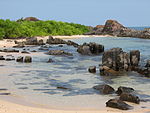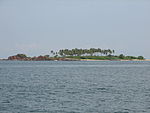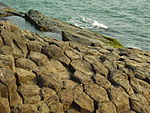St. Mary's Islands
St. Mary's Islands
Coconut Island | |
|---|---|
Island | |
UTC+5:30 (IST ) | |
| Four Islands -Coconut Island, the North Island, the Daryabahadurgarh Island and the South Island |
St. Mary's Islands, also known as Coconut Island and Thonsepar, are a set of four small islands in the
Scientific studies indicate that the basalt of the St. Mary's Islands was formed by sub-aerial subvolcanic activity, because at that time Madagascar was attached to India. The rifting of Madagascar took place around 88 million years ago.[2]
Columnar rhyolite Lava here form one of the four geological monuments in Karnataka state, one of the 34
History
In the year 1498,
Geography and topography
Out of the four islands, the northernmost island has a basaltic rock formation in a hexagonal form, the only one of its type in India such as Malpe and others. The island covers an area which is about 500 m (1,640.4 ft) in length with a width of 100 m (328.1 ft). It has prominent coconut trees, its cover reflecting an azure south sea colour, and hence the island is also called Coconut Island. There is no habitation on the islands.[9][10]
The north–south aligned islands form a non-continuous chain. The four largest islands are Coconut Island, North Island, Daryabahadurgarh Island and South Island.[11]
The islands are generally aligned parallel to the coast line, which provide clues to the phenomenon of uplift of the west coast of India. The islands' terraces and elevated beach deposits along with the tide gauge data at the dead oyster beach in
The highest elevation at Coconut Island, which has generated interest among geologists and tourists, is about 10 m (32.8 ft) above msl with surrounding areas in the form of platforms in the elevation range of +6 m (19.7 ft), +3 m (9.8 ft), +1.5 m (4.9 ft) and + 0 m which are stated to have been formed by wave action pointing to an "episodic sea level rise or fall of land".[2]
Geology

The columnar basaltic lava found in these Islands, which is very well developed in the basalts of Deccan Traps, exhibit an imposing range of hexagonal shaped or multi-faced (polygonal) columns split into a horizontal mosaic. In geological terms these are called "columnar joints".[1] The lava rocks form regular five, six or seven-sided pillars, called "laminar lava", and are found in varying heights in all the islands; the tallest of the columns is about 6 m (20 ft). Considering the importance and rarity of such an occurrence, these islands were classified as a National Geological Monument in 2001 by the Geological Survey of India.[8][10]
The Deccan Traps that formed during Cretaceous–Eocene time about 60 million years ago emerged from the vast deluge of hot molten basaltic lava in the western part of India which is now seen as flat topped hills and step like terraces.[1] Scientific studies carried out at the
- Islands comprise fully of igneous rocks. They have acid composition that consist of dacites, rhyodacites, rhyolites and granophyresand carry basic patches.
- The columnar jointing pattern is well developed on Coconut Island.
- Mineralogically, are recorded in the ground mass phases
- Magnetic granulometric studies (susceptibility and hysteresisat different temperatures) of island rock samples indicate the presence of a multi domain (MD) state of magnetite. It is inferred that: "the formation of MD could have affected the stability and consistency of magnetic directions in these rocks" and that "this igneous body has been either annealed or could be an intrusive."
An analysis of
Geological age
There are different theories on the age of the St. Mary's Islands rocks. In the analysis reported in the above section it has been further concluded that the multi domain (MD) state found in these rocks are uncommon in the
In a further analysis of the age of the break-up of Greater India (India plus
Another scientific study on the biogeographic and tectonic history of India reported that:[14] "Although real breaks among the lands were indicated by the physical data, faunal links were maintained by agile animals that were able to surmount minor marine barriers. India, during its northward journey, remained close to Africa and Madagascar even as it began to contact Eurasia."
General information
The western coasts of the islands are a seashell haven with seashells of various shapes and sizes littered along the coast. There is no sand beach to swim and relax since it is scattered with basaltic rocks. The beach has security guards who ensure that visitors do not venture into danger zones of the islands.[15]
All links to the island are only through the mainland town of Malpe, which is a major fishing harbor. The beach at this location is enlivening. It is located 5 km west of Udupi town, the administrative headquarters for the Islands. Apart from the Islands, Malpe too has tourist attractions such as the Vadabhandeshwara Temple and an image of
A detailed description of the natural flora and fauna of the islands and the Deria Bahdur Ghur (the islands north of the port of Malpe, named after the cross set up by Vasco da Gama), have been compiled in a manual by John Sturrocks, the district collector of Mangalore in 1894.[17]
Colonies of
- Visitor Information
The Islands are bereft of buildings, fences, shops. There are no domestic animals either. There are only covered pavilions with park benches on the shore and further inland. Visitors can wander around freely and enjoy the hexagonal formations from vantage locations. Visitors have to carry drinking water and sun screens since the climate is usually hot. Since the last few yards of the approach to the island involves wading, it may be preferable to avoid wearing sneakers.[18]
Access to the islands
The only way of getting to the islands is by boat. For advanced boating service visit malpe beach which is 5.8 km from town
near Mumbai. Malpe is 4 km (2.5 mi) from Udupi town.Pictures of St. Mary's Islands

See also
- List of places with columnar jointed volcanics
- Azores in the Atlantic Ocean
- Devils Postpile National Monument or The Cove Palisades State Park in the United States
- Fingal's Cave in Scotland
- Giant's Causeway in Northern Ireland
- Adam's Bridge in India-Sri Lanka border
References
- ^ a b c d "Columnar Rhyolite". Geological Survey of India. Archived from the original on 21 July 2011. Retrieved 26 July 2008.
- ^ a b c "Relative fall in Sea level in parts of South Karnataka Coast by K.R.Subramanya". Current Science Volume 75 Pages 727-730. Retrieved 25 January 2009.
- ^ "National Geological Monument, from Geological Survey of India website". Archived from the original on 12 July 2017. Retrieved 21 January 2019.
- ^ "Geo-Heritage Sites". pib.nic.in. Press Information Bureau. 9 March 2016. Retrieved 15 September 2018.
- ^ national geo-heritage of India Archived 11 January 2017 at the Wayback Machine, INTACH
- ^ "Geo-Heritage Sites".
- ^ "15 natural wonders in India you should know about". ibnlive.in.com/. Archived from the original on 1 September 2014. Retrieved 1 September 2014.
- ^ a b Prabhu, Ganesh (31 March 2006). "A beach and an island to relax on". The Hindu. Archived from the original on 13 December 2006. Retrieved 28 October 2008.
- ^ "St Mary's Island". Retrieved 24 January 2009.
- ^ a b "Where rocks tell a tale". The Hindu. 16 September 2002. Retrieved 24 January 2009.
- ^ a b c "Petrology and palaeomagnetism of volcanic rocks of the St. Marry Islands". Indian Institute of Technology, Doctoral thesis by A. B. Valsangkar. Retrieved 25 January 2009.
- ^ "Late Cretaceous India–Madagascar fit and timing of break-up related magmatism". Wiley Inter science, Terra Nova Volume 12, Issue 5, pages 220-224. 18 January 2002. Archived from the original on 5 January 2013. Retrieved 25 January 2009.
- . Retrieved 24 January 2009.
- .
- ^ "St Marys Island, Udippi, Karnataka". Maps of India. July 2011. Retrieved 9 February 2012.
- ^ "St Mary's Islands". Retrieved 24 January 2009.
- ^ Madhyastha, M.N.; Abdul Rahiman, M.; Kaveriappa, K.M. (1982). "A Brief History of Scientific Technology, Research and Educational Progress of South Kanara, Karnataka State" (PDF). Indian Journal of History of Science. 17 (2): 260–267. Retrieved 24 January 2009.
- ^ a b "St.Mary's Island". 30 January 2007. Retrieved 27 January 2009.





